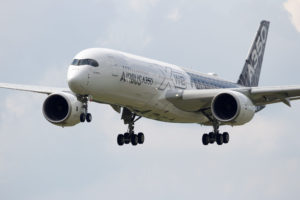
Photo: 123RF
An Airbus A350
Can an airplane complete a full flight on auto pilot?
There is some confusion on what constitutes a full flight. If we define it as from the departure gate, say from Kuala Lumpur to the London Heathrow arrival gate, then we cannot say that the auto pilot is capable of completing a full flight.
This is because there is no autopilot that is fully capable of steering a commercial airliner to the runway and take-off.
For an Airbus A350 operating a 13-hour flight to London, the autopilot is on for more than 99 % of the flight time until the plane comes to a complete stop during an auto landing. Normally, the autopilot is only engaged about 5 seconds or 100 feet after airborne.
On this 13-hours full flight, about 15 minutes is in fact for the push back to take off and another 15 minutes is from after landing until arriving at the gate. These 2 portions of the flight are yet to be perfected automatically.
As such, an airliner cannot complete a full flight on automation yet.
I digress here to briefly discuss the auto flight system and some effects of its mishandling.
Over the years, the autopilot, auto throttles and auto brakes have become a part of the flight management system.
Although the automation can take over the manipulation of the power, heading, and attitude, it cannot pull up the landing gear, retract the flaps or handle some critical emergencies.
Failing to understand how automation works has led to some notable disasters.
On 6 July 2013, an Asiana Boeing 777-200 crashed at San Francisco after the captain had selected an inappropriate autopilot mode which resulted in the auto-throttle no longer in control of the airspeed. There were only 3 fatalities out of 307 on board.
On 3 August 2016 a Boeing 777-300 rejected a landing at Dubai from the runway following a late touchdown. It then became airborne without either pilot noticing that the auto throttle was not responding.
The plane crashed because the flight crew were unaware that the auto throttle had not responded after the captain had initiated the go-around. Thankfully, all 300 on board survived.
The most tragic case of misunderstanding of how automation works happened on an Airbus A300-600 on a final landing at Nagoya on 26 April 1994. The crew were fighting against automation during an inadvertent mode selection and caused the plane to crash.
Here, the co-pilot had inadvertently made a selection which tells the autopilot to increase the throttles to the take-off/go-around power.
However, he went against the flow by physically reducing the power. He should have disconnected the autopilot. As such, the autopilot was still acting on the inadvertent command and increasing its own efforts to overcome the pilot’s action.
Here, it was a case of man fighting against the mighty machine. There were 264 fatalities.
Pilots today are learning from past mistakes and are therefore better trained to cope with such mishandlings.
See YouTube video Boeing 777 Crash in San Francisco – Asiana Airlines Flight 214
here https://www.youtube.com/watch?v=AlkRE3Jsefo
See YouTube video Boeing 777 Crashes at Dubai Airport
here https://www.youtube.com/watch?v=1cZAp75SSkA
See YouTube video Deadly Go-Around | China Airlines Flight 140
here https://youtu.be/cXuNoMa-Jco